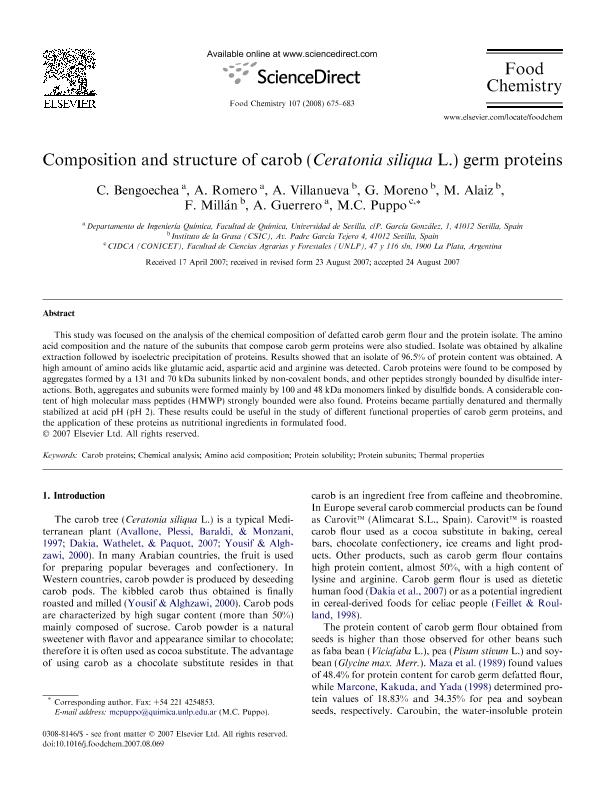Mostrar el registro sencillo del ítem
dc.contributor.author
Bengoechea, C.
dc.contributor.author
Romero, A.
dc.contributor.author
Villanueva, A.
dc.contributor.author
Moreno, G.
dc.contributor.author
Alaiz, M.
dc.contributor.author
Millán, F.
dc.contributor.author
Guerrero, A.
dc.contributor.author
Puppo, Maria Cecilia

dc.date.available
2022-06-08T13:55:22Z
dc.date.issued
2008-03
dc.identifier.citation
Bengoechea, C.; Romero, A.; Villanueva, A.; Moreno, G.; Alaiz, M.; et al.; Composition and structure of carob (Ceratonia siliqua L.) germ proteins; Elsevier; Food Chemistry; 107; 2; 3-2008; 675-683
dc.identifier.issn
0308-8146
dc.identifier.uri
http://hdl.handle.net/11336/159227
dc.description.abstract
This study was focused on the analysis of the chemical composition of defatted carob germ flour and the protein isolate. The amino acid composition and the nature of the subunits that compose carob germ proteins were also studied. Isolate was obtained by alkaline extraction followed by isoelectric precipitation of proteins. Results showed that an isolate of 96.5% of protein content was obtained. A high amount of amino acids like glutamic acid, aspartic acid and arginine was detected. Carob proteins were found to be composed by aggregates formed by a 131 and 70 kDa subunits linked by non-covalent bonds, and other peptides strongly bounded by disulfide interactions. Both, aggregates and subunits were formed mainly by 100 and 48 kDa monomers linked by disulfide bonds. A considerable content of high molecular mass peptides (HMWP) strongly bounded were also found. Proteins became partially denatured and thermally stabilized at acid pH (pH 2). These results could be useful in the study of different functional properties of carob germ proteins, and the application of these proteins as nutritional ingredients in formulated food.
dc.format
application/pdf
dc.language.iso
eng
dc.publisher
Elsevier

dc.rights
info:eu-repo/semantics/openAccess
dc.rights.uri
https://creativecommons.org/licenses/by-nc-sa/2.5/ar/
dc.subject
Carob proteins
dc.subject
Chemical analysis
dc.subject
Aminoacid composition
dc.subject
Protein solubility
dc.subject.classification
Alimentos y Bebidas

dc.subject.classification
Otras Ingenierías y Tecnologías

dc.subject.classification
INGENIERÍAS Y TECNOLOGÍAS

dc.title
Composition and structure of carob (Ceratonia siliqua L.) germ proteins
dc.type
info:eu-repo/semantics/article
dc.type
info:ar-repo/semantics/artículo
dc.type
info:eu-repo/semantics/publishedVersion
dc.date.updated
2022-05-12T16:32:40Z
dc.identifier.eissn
1873-7072
dc.journal.volume
107
dc.journal.number
2
dc.journal.pagination
675-683
dc.journal.pais
Países Bajos

dc.description.fil
Fil: Bengoechea, C.. Universidad de Sevilla; España
dc.description.fil
Fil: Romero, A.. Universidad de Sevilla; España
dc.description.fil
Fil: Villanueva, A.. Consejo Superior de Investigaciones Científicas; España
dc.description.fil
Fil: Moreno, G.. Consejo Superior de Investigaciones Científicas; España
dc.description.fil
Fil: Alaiz, M.. Consejo Superior de Investigaciones Científicas; España
dc.description.fil
Fil: Millán, F.. Consejo Superior de Investigaciones Científicas; España
dc.description.fil
Fil: Guerrero, A.. Universidad de Sevilla; España
dc.description.fil
Fil: Puppo, Maria Cecilia. Provincia de Buenos Aires. Gobernación. Comisión de Investigaciones Científicas. Centro de Investigación y Desarrollo en Criotecnología de Alimentos. Consejo Nacional de Investigaciones Científicas y Técnicas. Centro Científico Tecnológico Conicet - La Plata. Centro de Investigación y Desarrollo en Criotecnología de Alimentos. Universidad Nacional de La Plata. Facultad de Ciencias Exactas. Centro de Investigación y Desarrollo en Criotecnología de Alimentos; Argentina
dc.journal.title
Food Chemistry

dc.relation.alternativeid
info:eu-repo/semantics/altIdentifier/url/https://www.sciencedirect.com/science/article/abs/pii/S0308814607008746
dc.relation.alternativeid
info:eu-repo/semantics/altIdentifier/doi/http://dx.doi.org/10.1016/j.foodchem.2007.08.069
Archivos asociados
